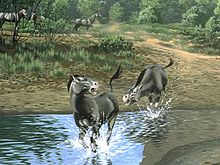| Kalobatippus | |
|---|---|

| |
| K. agatensis skull, American Museum of Natural History | |
| Scientific classification | |
| Domain: | Eukaryota |
| Kingdom: | Animalia |
| Phylum: | Chordata |
| Class: | Mammalia |
| Order: | Perissodactyla |
| Family: | Equidae |
| Subfamily: | †Anchitheriinae |
| Genus: | †Kalobatippus Osborn, 1915 |

Kalobatippus ('stilt walking horse') was a genus of anchitheriinae equid. It gets its name from the elongated bones between the ankle/wrist and the toes. Kalobatippus ate leaves and was characterized by unusually long legs. It lived 24 to 19 million years ago. Estimated body mass for Kalobatippus is 131.7 kg (290 lb).
References
- "Kalobatippus". Florida Museum of Natural History. Retrieved 12 April 2015.
- "From the Beginning". itsmypony.com. Retrieved 12 April 2015.
- Bruce J. MacFadden (1992). Fossil Horses: Systematics, Paleobiology, and Evolution of the Family Equidae. Cambridge University Press. p. 284. ISBN 0521477085. Retrieved 11 October 2022.
| Extinct genera of Equidae (Horse family), arranged by subfamily | |||||||||
|---|---|---|---|---|---|---|---|---|---|
| |||||||||
| Basal forms | |||||||||
| Anchitheriinae | |||||||||
| Equinae |
| ||||||||
| Taxon identifiers | |
|---|---|
| Kalobatippus | |
This prehistoric odd-toed ungulate-related article is a stub. You can help Misplaced Pages by expanding it. |
This equine-related article is a stub. You can help Misplaced Pages by expanding it. |








